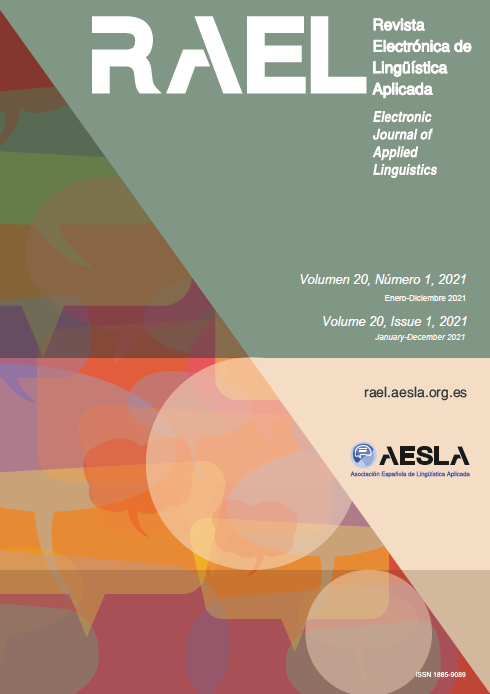Towards an Empirical Characterisation and a Corpus-Driven Taxonomy of Fragments in Written Contemporary English
Palabras clave:
fragment, ellipsis, corpus-driven, written discourse, parsingResumen
This study investigates ‘fragments’ in contemporary English. Fragments are structurally non-canonical constituents that convey the propositional meaning of a full clause, such as Good Old Hendon next stop or What a weirdo. This investigation constitutes an innovative approach to the topic since it (i) explores fragments in exclusively written (i.e. planned/edited) discourse, and (ii) aims at providing a corpus-driven taxonomy and an empirical account of the constructions, strategies and phenomena that are classifiable as fragments based on linguistically objectifiable (formal/textual) criteria, two areas much neglected in prior literature. The results reveal that fragments are not uncommon in written registers, particularly in letters and novels/stories. The most frequent types identified are phrasal and verbless, followed by clausal, wh-fragments and Small Clauses. Most of them show a high rate of subject and/or verb omission whose recoverability in context is facilitated by means of functional elements or latent lexical items licensed by the construction itself.
Citas
Barton, E. L. (1990). Nonsentential Constituents: A Theory of Grammatical Structure and Pragmatic Interpretation. Amsterdam and Philadelphia: John Benjamins.
Barton, E. & Progovac, L. (2005). Nonsententials in minimalism. In R. Elugardo & R. J. Stainton (Eds.), Ellipsis and Non-Sentential Speech (pp. 71-93). Dordrecht: Kluwer.
Beijering, K., Kaltenböck, G. & Sansiñena, M. S. (2019). Insubordination: Central issues and open questions. In K. Beijering, G. Kaltenböck & M. S. Sansiñena (Eds.), Insubordination: Theoretical and Empirical Issues (pp. 1-28). Berlin: Mouton de Gruyter.
Bezuidenhout, A. (2013). Structuring silence versus the structure of silence. In L. Goldstein (Ed.), Brevity (pp. 36-52). Oxford: Oxford University Press.
Biber, D., Johansson, S., Leech, G., Conrad, S. & Finegan, E. (1999). Longman Grammar of Spoken and Written English. London: Longman.
Bowie, J. & Aarts, B. (2016). Clause fragments in English dialogue. In M. J. López-Couso, B. Méndez-Naya, P. Núñez-Pertejo & I. M. Palacios-Martínez (Eds.), Corpus Linguistics on the Move: Exploring and Understanding English through Corpora (pp. 259-288). Leiden and Boston: Brill.
Bowie, J. & Popova, G. (2019). Grammar and discourse. In B. Aarts, J. Bowie & G. Popova (Eds.), The Oxford Handbook of English Grammar (pp. 554-580). Oxford: Oxford University Press.
Cappelle, B. (2020). Not on my watch and similar not-fragments: Stored forms with pragmatic content. Acta Linguistica Hafniensia, 52(2), 217-239. doi: 10.1080/03740463.2020.1812365
Cappelle, B. (2021). Not-fragments and negative expansion. Constructions and Frames, 13(1), 55-81. doi: 10.1075/cf.00047.cap
Carston, R. (2002). Linguistic meaning, communicated meaning and cognitive pragmatics. Mind and Language, 17, 127-148. doi: 10.1111/1468-0017.00192
Fernández Rovira, R. (2006). Non-Sentential Utterances in Dialogue: Classification, Resolution and Use (PhD thesis). King’s College London, UK.
Fernández, R. & Ginzburg, J. (2002). Non-sentential utterances in dialogue: A corpus-based study. Traitement Automatique des Langues, 43(2), 13-42.
Fernández, R., Ginzburg, J. & Lappin, S. (2007). Classifying non-sentential utterances in dialogue: A machine learning approach. Computational Linguistics, 33(3), 397-427. doi: 10.1162/coli.2007.33.3.397
Fillmore, C. J., Kay, P. & O’Connor, M. C. (1988). Regularity and idiomaticity in grammatical constructions: The case of Let alone. Language, 64(3), 501-538. doi: 10.2307/414531
Ginzburg, J. & Sag, I. A. (2000). Interrogative Investigations: The Form, Meaning, and Use of English Interrogatives. Stanford, CA: Center for the Study of Language and Information.
Goldberg, A. E. (1995) Constructions: A Construction Grammar Approach to Argument Structure. Chicago, IL: University of Chicago Press.
Goldberg, A. E. (2006) Constructions at Work: The Nature of Generalization in Language. Oxford: Oxford University Press.
Goldberg, A. E. & Perek, F. (2019). Ellipsis in Construction Grammar. In J. van Craenenbroeck & T. Temmerman (Eds.), The Oxford Handbook of Ellipsis (pp. 188-204). Oxford: Oxford University Press.
Greenbaum, S. & Nelson, G. (1999). Elliptical clauses in spoken and written English. In P. Collins & D. A. Lee (Eds.), The Clause in English: In Honour of Rodney Huddleston (pp. 111-125). Amsterdam and Philadelphia: John Benjamins.
Hall, A. (2007). Subsentential utterances, ellipsis, and pragmatic enrichment. UCL Working Papers in Linguistics, 19, 235-259.
Hall, A. (2019). Fragments. In J. van Craenenbroeck & T. Temmerman (Eds.), The Oxford Handbook of Ellipsis (pp. 605-623). Oxford: Oxford University Press.
Hankamer, J. (1979). Deletion in Coordinate Structures. New York: Garland.
Harnish, R. M. (2009). The problem of fragments. Two interpretative strategies. Pragmatics & Cognition, 17(2), 251-282. doi: 10.1075/pc.17.2.03har
Huddleston, R. & Pullum, G. K. (2002). The Cambridge Grammar of the English Language. Cambridge: Cambridge University Press.
Laury, R. & Ono, T. (Eds.) (2020). Fixed Expressions: Building Language Structure and Social Action. Amsterdam and Philadelphia: John Benjamins.
Kline, C. R. Jr. & Memering, W. D. (1977). Formal fragments: The English minor sentence. Research in the Teaching of English, 11(2), 97-110.
Malá, M. (2000). Irregular sentences in colloquial English. Acta Universitatis Carolinae, Philologica 5, 1997. Prague Studies in English, 22, 79-90.
Malá, M. (2001). Irregularities of sentence structure in contemporary colloquial English. In Proceedings of The 6th Conference of British, American, and Canadian Studies (pp. 42-48). Opava: Silesian University.
Merchant, J. (2004). Fragments and ellipsis. Linguistics and Philosophy, 27(6), 661-738. doi: 10.1007/s10988-005-7378-3
Morgan, J. L. (1973). Sentence fragments and the notion ‘sentence’. In B. B. Kachru, R. B. Lees, Y. Malkiel, A. Pietrangeli & S. Saporta (Eds.), Issues in Linguistics: Papers in Honor of Henry and Renée Kahane (pp. 719-751). Chicago, IL: University of Illinois Press.
Nelson, G., Wallis, S. & Aarts, B. (2002). Exploring Natural Language: Working with the British Component of the International Corpus of English. Amsterdam and Philadelphia: John Benjamins.
Progovac, L., Paesani, K., Casielles, E. & Barton, E. (2006). The Syntax of Nonsententials: Multidisciplinary Perspectives. Amsterdam and Philadelphia: John Benjamins.
Purver, M., Ginzburg, J. & Healy, P. (2001). On the means for clarification in dialogue. In J. van Kuppevelt & R. Smith (Eds.), Current and New Directions in Discourse and Dialogue (pp. 235-256). Dordrecht: Kluwer Academic Publishers.
Quirk, R., Greenbaum, S., Leech, G. & Svartvik, J. (1985). A Comprehensive Grammar of the English Language. London: Longman.
Sadock, J. M. & Zwicky, A. M. (1985). Speech act distinctions in syntax. In T. Shopen (Ed.), Language Typology and Syntactic Description, vol.1: Clause Structure (pp. 155-196). Cambridge: Cambridge University Press.
Schlangen, D. & Lascarides, A. (2003). The interpretation of non-sentential utterances in dialogue. In Proceedings of the 4th SIGdial Workshop on Discourse and Dialogue (pp. 62-71). Retrieved from https://www.aclweb.org/anthology/W03-2106.pdf
Schuster, E. H. (2006). A fresh look at sentence fragments. The English Journal, 95(5), 78-83. doi: 10.2307/30046593
Stainton, R. J. (2004). The pragmatics of non-sentences. In L. R. Horn & G. Ward (Eds.), The Handbook of Pragmatics (pp. 266-287). Oxford: Blackwell.
Stainton, R. J. (2006). Words and Thoughts: Subsentences, Ellipsis, and the Philosophy of Language. Oxford: Oxford University Press.
Stanley, J. (2000). Context and logical form. Linguistics and Philosophy, 23, 391-434. doi: 10.1023/A:1005599312747
Wray, A. (2002). Formulaic Language and the Lexicon. Cambridge: Cambridge University Press.
Descargas
Publicado
Número
Sección
Licencia
Derechos de autor 2022 Yolanda Fernández-Pena

Esta obra está bajo una licencia internacional Creative Commons Atribución-NoComercial 4.0.
Reconocimiento – No comercial (CC BY-NC). Bajo esta licencia el usuario puede copiar, distribuir y exhibir públicamente la obra y puede crear obras derivadas siempre y cuando estas nuevas creaciones reconozcan la autoría de la obra original y no sean utilizadas de manera comercial.
Los autores retienen todos sus derechos de publicación y copyright sin restricciones.









